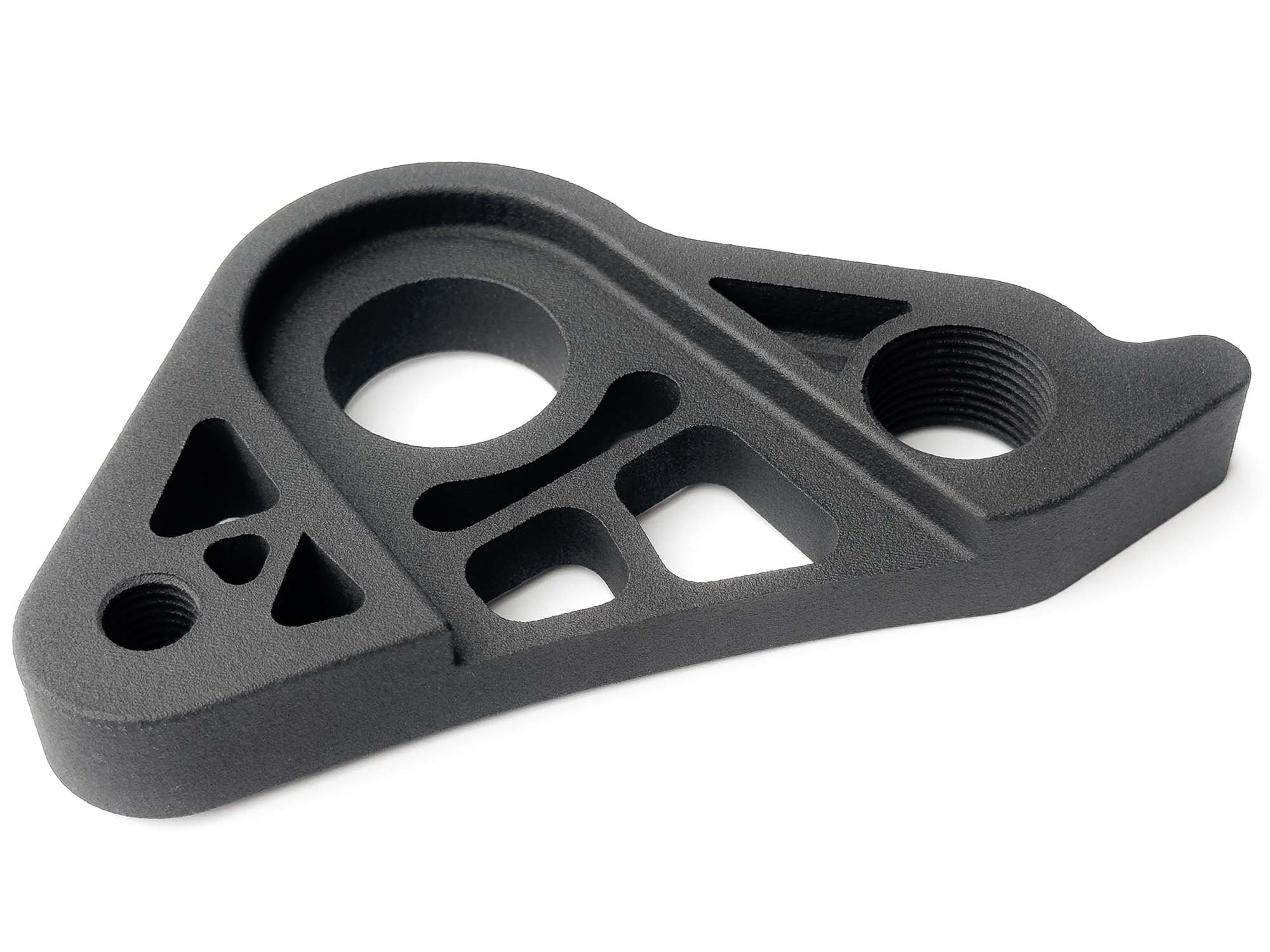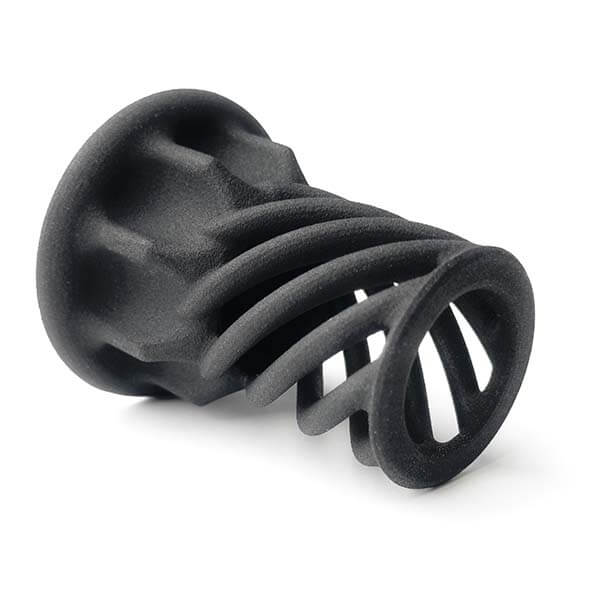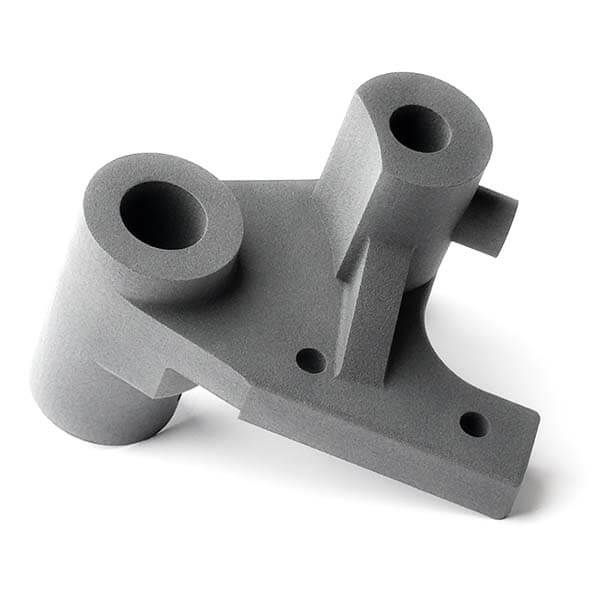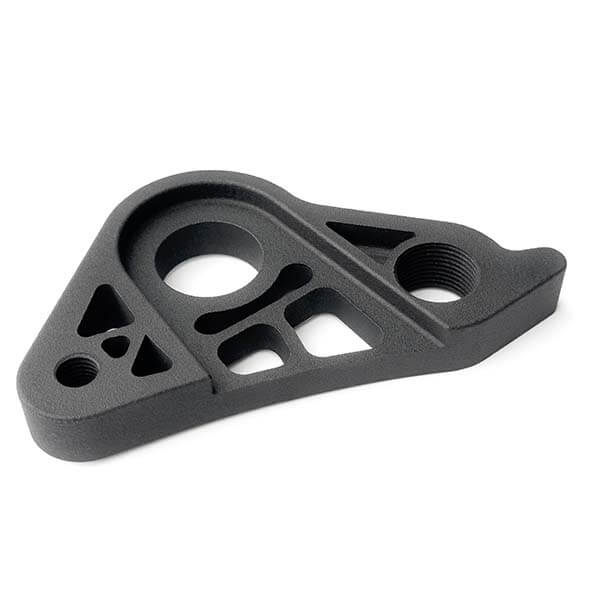Nylon PA 11
Flexible, durable and more sustainable than PA12
PA11 nylon is a bio-based polyamide with excellent impact resistance, high flexibility, and long-term durability. Compared to PA12, it offers greater elasticity and a lower environmental impact. It is resistant to wear, abrasion, and many chemicals, with low-friction properties ideal for technical and functional components.

PROS
- More flexible than PA12
and more impact resistant - Produced from green renewable sources
- Better to reproduce small details and low thicknesses
CONS
- Larger tolerances with respect to PA12
- Slightly hygroscopic
- More expensive than PA12
MAIN FEATURES
- 3D printing process: MJF
- Tolerance: < 100mm ± 0,50mm; > 100mm ± 0,5%
- Max size: 380 x 284 x 380 mm; 15 x 11.2 x 15 in
- Lead time: <5 days
- Available finishes: dyeing, vapor smoothing, semi-matt, semi-gloss and metallic painting
PA11 3D PRINTING VIDEO GALLERY
Flexibility and impact resistance
Nylon PA11 stands out in the panorama of thermoplastic polymers due to its exceptional mechanical properties, which make it particularly appreciated in a wide range of industrial and consumer applications. Compared to PA12, PA11 offers greater flexibility, a characteristic that makes it ideal for components that require good deformation capability without cracking. In addition, this material has superior impact resistance, providing excellent performance even under the most extreme conditions and ensuring greater durability of finished products.
Produced from green renewable resources
Nylon PA11 is an excellent demonstration of how technological innovation can be combined with environmental and social sustainability. This material, derived entirely from renewable resources, is produced from castor oil, a choice that eliminates any form of competition with the production of food or other commodities. In fact, castor oil thrives in marginal soils where other agricultural crops struggle to grow, and makes limited use of water, effectively harnessing the natural monsoons for its sustenance. Thanks to these characteristics, nylon PA11 is positioned as a pioneering material, capable of combining industrial innovation with environmental and social responsibility.
Ideal for fine details and thicknesses
Polyamide PA11 stands out for its exceptional adaptability in the production of parts with fine details and thin surfaces, thanks to HP Multi Jet Fusion 3D printing technology. This advanced technology enables the creation of 100% solid parts without the need for substrates, allowing designers to explore complex designs that would be difficult, if not impossible, to realise with traditional production methods.
Free quote for your PA11 parts
Upload your 3d file and turn your ideas into reality
free instant quoteNYLON PA11 GALLERY
NYLON PA11 COMMENT
Nylon PA11 is a premium technical thermoplastic, offering superior performance for a wide range of applications. With greater flexibility and impact resistance than PA12, it is characterised by better chemical resistance and a more environmentally friendly approach than other technical thermoplastics.
We produce your PA11 creations using HP Multi Jet Fusion 3D printing. The parts are 100 % full and require no substrates, allowing designers to explore complex designs without the limitations typical of other production processes.
Pros
Rapid Production: MJF (Multi Jet Fusion) technology makes nylon PA11 extremely efficient for rapid production. This technology makes it possible to produce from single prototypes to large series of parts in remarkably short times. The ability to print quickly and accurately makes PA11 an ideal choice for projects requiring short production times without compromising quality.
Strength and Durability: Nylon PA11 is characterised by its exceptional impact resistance and flexibility. These properties make it an ideal material for industrial applications where strength and reliability are paramount. Its ability to absorb shocks and maintain structural integrity under stress makes it suitable for mechanical components, machine parts and objects that are subjected to regular stress.
Excellent Chemical Resistance: PA11 shows superior resistance to a wide range of chemicals, including oils, greases, hydrocarbons and solvents. This characteristic makes it particularly suitable for use in sectors such as the chemical industry, where materials are frequently exposed to aggressive substances. In addition, it is in great demand in the automotive and medical equipment industries, where chemical resistance is essential to ensure the safety and durability of components
Environmentally friendly: Nylon PA11 is not only a high-performance material, it is also environmentally friendly. Derived from renewable resources such as castor oil and sugar cane, its production process has a significantly lower environmental impact than traditional petroleum-derived thermoplastics. This characteristic makes it a preferable choice for companies and designers concerned about the sustainability and environmental impact of their products.
Cons
Higher Tolerances: One of the characteristics of Nylon PA11 is that it can have slightly higher dimensional tolerances than PA12. This is especially important in applications where dimensional accuracy is crucial. Larger tolerances may require more accurate and careful design to ensure that 3D-printed parts meet specific requirements. In some cases, it may be necessary to make design adjustments or consider post-print finishing processes to achieve the desired dimensions. This is particularly relevant in industries such as aerospace and automotive, where tight tolerances are often a necessity.
Slightly Hygroscopic: Nylon PA11 is slightly hygroscopic, which means that it tends to absorb moisture from the environment. This characteristic requires special care when storing and handling the material prior to printing. It is important to store PA11 in humidity-controlled environments or in sealed containers to prevent moisture absorption, which could adversely affect its printing properties and the quality of the finished product. In addition, it may be necessary to dry the material before printing to ensure that moisture does not affect the quality of the print. This is crucial to maintain the optimum consistency and mechanical properties of PA11 in final applications.
Applications of Nylon 11
Aerospace: Used to produce lightweight yet strong components, such as fairings and internal structural parts of aircraft. Its impact resistance and light weight make it ideal for this sector.
Oil and gas industry: Due to its excellent chemical resistance, PA11 is often used to make hoses and equipment components resistant to oil, gas and other corrosive fluids.
Automotive: In the automotive industry, PA11 is used for the production of interior and exterior vehicle parts, including engine components, linings and gaskets. Its impact and chemical resistance makes it suitable for these applications.
Sports: PA11 is used in the production of sports equipment, such as tennis rackets, gym equipment and bicycle components, due to its combination of strength and flexibility.
Electronics: Used as an insulating and protective material for cables, connectors and housings of electronic devices, due to its resistance to temperature and chemicals.
Fashion: Used for strong and lightweight accessories, such as belt buckles, glasses and shoe parts.
Comparison with other materials
Resin: Nylon PA11 outperforms resin in several crucial aspects, particularly in terms of strength and flexibility. While resin can offer a smooth surface finish and fine detail, it tends to be more brittle and less impact resistant than PA11. This makes PA11 nylon a better choice for parts that must withstand high loads, frequent impacts or wear over time. Its resilience makes it ideal for applications where durability is a priority.
ABS: ABS is another popular material in 3D printing, known for its strength and durability. However, nylon PA11 has the advantage of offering superior abrasion and chemical resistance. This makes it more suitable for applications in aggressive environments where materials may be exposed to chemicals or abrasion. In addition, PA11 tends to retain its shape and dimensions better, offering superior dimensional stability compared to ABS, especially under thermal stress.
Nylon PA12: Although PA11 and PA12 are chemically similar, they have significant differences in their properties and applications. PA11, being derived from renewable resources, has a lower environmental impact. It offers superior performance in terms of heat resistance, light stability and flexibility, making it suitable for applications requiring these characteristics. On the other hand, PA12, with its higher stiffness and crack resistance, is ideal for applications requiring resistance to extreme temperatures and long-term durability. The decision between PA11 and PA12 depends on the specific requirements of the project. PA11 is the best choice for applications requiring high impact resistance, flexibility and a low environmental footprint. PA12, on the other hand, is more suitable for products that need resistance to drastic temperatures and cracking. Both materials offer unique advantages, and the choice should be based on a careful evaluation of the specific needs for strength, durability, environmental impact and other properties required for the final application.
Conclusion
In conclusion, nylon PA11 emerges as an exceptionally versatile and high-performance material in the field of 3D printing. With its distinctive advantages in terms of fast production, superior impact resistance, flexibility, chemical resistance and environmental sustainability, it is positioned as an excellent choice for a wide range of applications. Its ability to outperform materials such as resin and ABS in key aspects such as abrasion resistance and chemical stability makes it particularly suitable for demanding industrial environments and applications requiring long-term durability and reliability.
Comparison with PA12 further highlights its uniqueness, offering greater flexibility and reduced environmental impact while maintaining excellent mechanical properties. This combination of features makes PA11 not only a pragmatic choice for manufacturers and designers, but also a step towards more sustainable and environmentally friendly production solutions.
All in all, nylon PA11 establishes itself as a material at the forefront of 3D printing, suitable to meet the needs of a wide variety of sectors, from industrial manufacturing to aerospace, from automotive to fashion. Its versatility, combined with its superior properties, makes it an ideal choice for those seeking a material that combines innovation, performance and environmental responsibility.
MATERIAL PROPERTIES
| Tensile breaking load | 52 MPa |
| Modulus of elasticity | 1770 MPa |
| Elongation at break | 27,5% |
| Elongation at Yield |
23% |
| Resilience | 5 kJ/m² |
"As a designer, I am proud to have the opportunity to use my creativity to bring my visions to life and create something that makes a difference."
Questions and answers on NYLON PA11
Nylon PA11 and Nylon PA12, while sharing similar chemical characteristics, differ significantly in their properties, production processes, and ideal applications. PA11 is derived from renewable resources, particularly castor oil, making it a more sustainable choice compared to PA12, which originates from petrochemical sources. This makes PA11 preferable for projects where environmental impact is a key consideration. In terms of physical properties, PA11 offers higher thermal resistance and better light stability, making it ideal for applications exposed to challenging environmental conditions or temperature fluctuations. Additionally, PA11 is more flexible and resilient than PA12, which makes it suitable for components requiring greater impact resistance or deformation tolerance, such as automotive or sports sector devices. On the other hand, PA12 is characterised by superior rigidity and higher resistance to cracking and chemical agents. It is particularly suitable for applications requiring durable and stable components that maintain their structural integrity over time, even under high loads or in environments exposed to oils and greases. Its dimensional stability and ability to withstand extreme temperatures make it an excellent choice for industrial and mechanical sectors.
Nylon PA11 is a thermoplastic polymer offering excellent thermal properties, making it ideal for a wide range of industrial applications. Its melting temperature is 202 °C, while its Vicat softening temperature is 175 °C. Additionally, the material exhibits a heat deflection temperature (HDT) of 185 °C under a 0.45 MPa load and 54 °C under a 1.8 MPa load. These characteristics provide Nylon PA11 with remarkable dimensional stability and heat resistance, enabling it to maintain its mechanical properties even under high-temperature operating conditions. Furthermore, PA11 provides good thermal stability with a continuous service temperature range from -40 °C to 125 °C, making it suitable for both extremely cold and high-temperature environments. The material can also withstand thermal peaks of up to 190 °C, which makes it particularly useful for applications requiring resistance to sudden temperature variations or exposure to extreme heat. These attributes position PA11 as an excellent choice for industries demanding reliable performance in thermally challenging environments.
Nylon PA11 is a versatile material widely used across various industrial sectors due to its mechanical, chemical, and thermal properties, along with its sustainability stemming from its production from renewable resources such as castor oil. In the aerospace sector, it is employed for the production of lightweight and durable components, such as fairings and internal structural parts of aircraft, owing to its high impact resistance and lightness. In the oil and gas industry, PA11 is chosen for flexible piping and equipment components that must resist exposure to petroleum, gas, and corrosive fluids, making it an ideal solution for particularly aggressive operating environments. In the automotive sector, it is extensively used for producing interior and exterior vehicle parts, such as engine components, linings, and seals, where impact resistance and chemical durability are essential. Thanks to these characteristics, Nylon PA11 is an excellent choice for applications requiring high durability, reliability, and a sustainable approach.
QUOTE IN 1 SECOND WITHOUT COMMITMENT
how much does it cost to make your parts on PA11?
Upload your 3d and find out now
free instant quote




